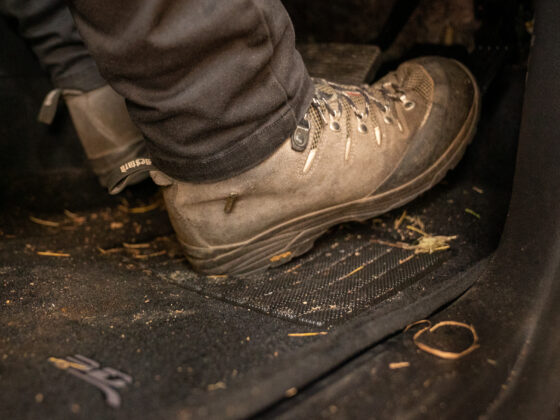When you think of essential 4X4 accessories, your mind probably jumps to things like recovery gear, bull bars, or maybe even a lift kit. But what if I told you one of the most useful items you can take on your next off-road adventure doesn’t bolt to your rig or add any weight to your GVM? Enter the often-overlooked 4X4 accessory—polarised sunglasses. Sure, they’re great for a casual drive, but when it comes to off-roading, a good pair of polarised sunnies can be the unsung hero of your setup, offering benefits that could genuinely improve your experience behind the wheel.
Seeing Through the Glare
Glare is any 4X4ers nightmare. Whether it’s the blinding reflection off a sandy track in the Outback or the shimmer bouncing off water during a creek crossing, glare can obscure what’s really going on beneath your tyres. That’s where polarisation comes into play.
Polarised sunglasses work by filtering out horizontal light waves that cause glare, which means you’re not just cutting down on eye strain, you’re actually improving your ability to see hazards. Imagine approaching a shallow water crossing. Without polarised lenses, the surface of the water reflects the sky and everything around it, effectively blinding you to what’s beneath. But with polarised lenses, those reflections are minimised, letting you see the rocks, branches, or unexpected dips that could ruin your day—or worse, your rig.

Navigating River Crossings
If you’ve spent any time 4X4ing in areas with rivers and streams, you’ll know how challenging crossings can be. Not only do you have to be aware of water depth, but submerged obstacles are just as critical to spot. Polarised sunglasses are like having a cheat code for this; they cut through surface reflections, giving you a much clearer view of what lies beneath. You can more easily gauge the depth of the water and spot rocks or logs that could pose a serious risk to your undercarriage or wheels.
In shallow crossings, especially those with clear water, a good pair of polarised sunglasses can give you the upper hand in selecting the safest path across. They won’t make the crossing itself any easier, but they can certainly help you make better, more informed decisions about where and how to tackle it.
Long Outback Drives? No Worries
Anyone who’s taken on the endless stretches of sunbaked roads in the Australian Outback knows the physical toll it takes. The glare from the road, especially on those hot days when the bitumen starts shimmering, can lead to intense eye strain and fatigue. Driving for hours under these conditions without proper eye protection is like staring at a lightbulb—it’s exhausting and can leave you feeling mentally drained long before you reach your destination.
A quality pair of polarised sunglasses can drastically reduce that fatigue. By filtering out the harshest light and cutting down on glare, they help keep your vision sharp and your eyes relaxed. You’ll be more alert and less likely to make mistakes from tiredness, which is critical on those long, remote drives where a momentary lapse in concentration can have serious consequences.
Spotting Washouts and Sand Tracks
Glare isn’t just a problem around water—it can also mask subtle terrain changes in sandy or dusty environments. If you’ve ever driven through the desert or on the coast, you’ll know how the sun reflecting off a light-coloured surface can make it difficult to spot washouts or dips in the track. One minute you’re cruising along a smooth stretch of sand, the next you’re nose-first into a hole that you didn’t see coming.
Polarised sunglasses help here too. By reducing the overall glare, they allow you to pick up on those minor variations in the surface, such as the shadow of a washout or the slight difference in texture that signals a change in terrain. This could mean the difference between an easy drive and a sudden, jarring surprise that might leave you needing recovery gear.
Reducing Eye Strain and Increasing Comfort
Let’s face it—4X4ing isn’t always the most comfortable experience, especially when you’re driving for hours on end. The last thing you need is your eyes working overtime. Constantly squinting or straining to see through the glare not only makes for an unpleasant experience but also takes your focus away from the track.
By reducing the strain on your eyes, polarised sunglasses let you stay comfortable for longer. You’ll be less prone to headaches, and your overall awareness of your surroundings will improve. After all, 4X4ing requires constant attention, and anything that reduces distractions and discomfort is going to make you a better, safer driver.

Choosing the Right Pair
Not all sunglasses are created equal, and when it comes to 4X4ing, you want to make sure you’ve got a pair that’s up to the task. Companies like TONIC Eyewear, which specialises in high-performance sunglasses designed for the Australian outdoors, are perfect examples of what to look for. Their lenses not only provide superior polarisation but also feature advanced coatings to reduce reflections from the inside of the lens, further improving clarity and reducing eye strain.
Their photochromic lenses are a game-changer as well, automatically adjusting to light conditions. When you’re driving through the changing light of a forest trail or heading out into the blazing sun of a salt flat, these lenses adapt, so you don’t have to swap out glasses or deal with compromised vision.
The Verdict: Don’t Underestimate the Power of a Good Pair of Sunnies
While a good pair of polarised sunglasses might not be the first accessory you think of when packing for your next off-road adventure, they should definitely be on your list. From cutting through the glare on water crossings and sandy tracks to keeping you comfortable and alert on long stretches of Outback roads, they’re one of the simplest yet most effective upgrades you can make.
Next time you’re gearing up for a big trip, make sure you’ve got a reliable pair of polarised sunnies. Your eyes—and your 4X4—will thank you.













